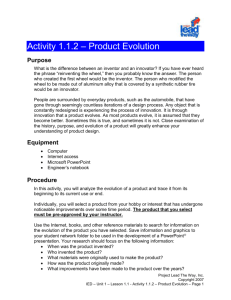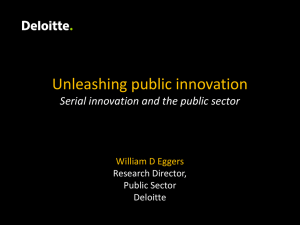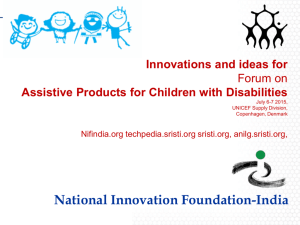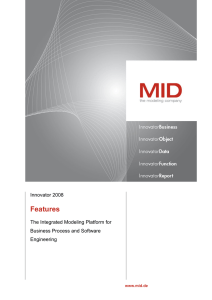innovator's game instructions
advertisement
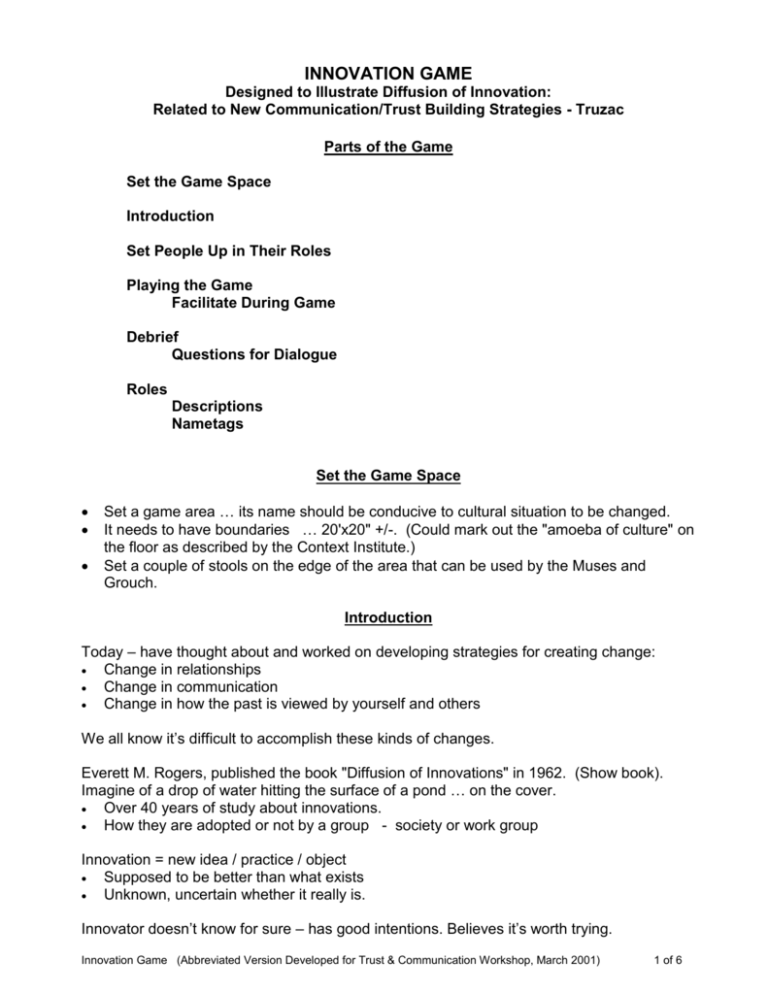
INNOVATION GAME Designed to Illustrate Diffusion of Innovation: Related to New Communication/Trust Building Strategies - Truzac Parts of the Game Set the Game Space Introduction Set People Up in Their Roles Playing the Game Facilitate During Game Debrief Questions for Dialogue Roles Descriptions Nametags Set the Game Space Set a game area … its name should be conducive to cultural situation to be changed. It needs to have boundaries … 20'x20" +/-. (Could mark out the "amoeba of culture" on the floor as described by the Context Institute.) Set a couple of stools on the edge of the area that can be used by the Muses and Grouch. Introduction Today – have thought about and worked on developing strategies for creating change: Change in relationships Change in communication Change in how the past is viewed by yourself and others We all know it’s difficult to accomplish these kinds of changes. Everett M. Rogers, published the book "Diffusion of Innovations" in 1962. (Show book). Imagine of a drop of water hitting the surface of a pond … on the cover. Over 40 years of study about innovations. How they are adopted or not by a group - society or work group Innovation = new idea / practice / object Supposed to be better than what exists Unknown, uncertain whether it really is. Innovator doesn’t know for sure – has good intentions. Believes it’s worth trying. Innovation Game (Abbreviated Version Developed for Trust & Communication Workshop, March 2001) 1 of 6 Rogers looks at how change happens. How is an idea spread Who accepts it – thinks it’s good and why Who doesn’t accept it and why One thing we know is that it doesn’t take 100% of people in the group to accept an innovation. Even 10-15% who accept the idea can successfully spread it to others – and it’s irreversible, takes hold. “Never doubt that a small group of thoughtful, committed citizens can change the world. Indeed, it's the only thing that ever has.” Margaret Mead Game created by the Context Institute in Washington state to demonstrate what can happen in an organization when someone has a good idea – or so they think. How does a new idea take hold or not. How do others adapt to it, or not. Creators also believed it could be “something different to do at your next party!” Based on Rogers book, they have described the kinds of roles people play in the innovation process. You probably recognize some of them: This is simply a model – illustrates principles of cultural change – how do new ideas, technologies, values or ways of working spread through a culture. It can happen in ways illustrated by the game, although not necessarily exactly this way. Not the real thing, not as complex, focuses on selected features – especially on how communication goes through certain channels over time. This game asks and answers questions: How do we decide if an idea is good? How does it spread through communication? Who accepts and it – who doesn’t? Set Up Roles Each person plays a role we find in organizations. You may recognize some. Read roles: Innovator - The progenitor of new ideas, leading edge explorer, inventor … sometimes on the "fringe" or "eccentric," or "creative" by the mainstream. (N=1) Change Agent - The "new idea broker" for the Innovator, the promoter of new ideas, solutions and direction; the marketer of innovation and communicator of change. (N=2) Muse - The creative imagination of the Innovator … the group in group genius. (N=2) Mainstreamer - The "noisy majority" busy with the basics of life, keeping things running day-to-day; neither for or against change, often unaware that it's happening; will change when other Mainstreamers change. (N=2) Innovation Game (Abbreviated Version Developed for Trust & Communication Workshop, March 2001) 2 of 6 Transformer - An early adopter in the mainstream; open to new ideas; wants to promote positive change; often a forward-thinking member of a mainstream organization. Laggard - A Mainstreamer who doesn't like change in general; late adopter of the innovation; changes only under pressure from the majority. Reactionary - Has a vested interest in keeping things as they are or in moving in the opposite direction; actively resists the adoption of the innovation; sometimes has an economic or power interest in the status quo; changes only if unavoidable, and then very late in the process. Grouch - The one who dislikes society and has abandoned it; angry or disillusioned within the Mainstream. Facilitator Note: Perspectives in relation to innovation – Positive – Innovator, Change Agent, Muse, Transformer (min. 6) Negative – Reactionary, Laggard, Grouch (min. 3) Could go either way – Mainstreamers (min. 2) Playing the Game With that background, it’s time to move to the game area. Innovation that you will work with – the good idea that may or may not be accepted: is Truzac, a product that can improve communication and strengthen trust. Will learn more during the game. (Remember – “no wrong answer”) You are the group to whom this innovative product is introduced. Most people will be inside the circle of play marked by walls and/or chairs. A few will be on the outside looking in. Be rigorous and at risk in their role playing. [“If you can't have fun with the problem. . . “] Participants will draw roles from the hat and play whatever comes. The role may or may not be "who they think they are" in the cultural change process. Have people draw their roles from the hat. You’ll discover about each other through the process of play, so not to read each other’s role descriptions Take a few minutes to read your own role description and imagine yourelf in the role. Place the nametag in the holder behind their name. Note that the game will last about twenty minutes. It is over when the innovation has successfully spread through the culture - or it's obvious that it never will. Be available to answer questions, interpret, and determine length of play. Nudge players along, give them hints. Make sure the Innovator gets moving on innovating, finding the Change Agents, getting advice from the muses … or nothing will happen [it's own lesson]. Be ready to respond to fast changing circumstances, interpret rules on the spot, make up new ones. Keep the process out of total chaos. Innovation Game (Abbreviated Version Developed for Trust & Communication Workshop, March 2001) 3 of 6 Debrief: What Happened? How did it feel to be in your role? What happened? What were you thinking? Start with Innovator Then, invite others to join conversation What did you observe about yourself? About others’ reactions to you? Call on the Curmudgeon for comments if he/she doesn’t offer them. Does it make a difference if he/she is invited to join the circle? What strategies did you use? What worked . . . didn’t work? 1-1 lobbying Call the group together. Working with individuals/types What roles do you see in your department? What are your strategies for working with them? Note that most people play several roles. Mainstreamers - give info; involve in the details Grouch - invite in; don’t allow it Change agents, etc. Note: how subgroups formed, communication occurred, the group decided whether to accept the idea Power of negativity. A little goes a long way. Note that most people favored the idea. Role of the manager Recognize nature of change Does anyone really like it? It is messy and full of surprises Takes a long time – why? Bureaucracy, status quo, lack of resources Difficult: “How do you change the tires of car that’s 60 miles per hour?” How change occurs. Incremental v. leap Momentum – Tipping Point. Hush Puppies – mid ‘90s; ready to go out of business. Become posh wear in hip NY circles – by kids who were wearing because no one else would. Spread by word of mouth fashion designers. What it takes to make a successful change Relative advantages and observable Compatible with past experience Understandable and communicated – Shared vision, clear, direct, continuous. Keep high confidence. Use media to let others know about advantages. Can try it out – test it and have other see it. Personal modeling where possible Participation – Teamwork Steps / plan are clear and communicated Politics – Institutionalize the innovation or create a system that encourages it Relate to syntopicals, other assignments. Roles / Play Instructions These need to be made into individual cards that players can draw, along with a nametag. Innovation Game (Abbreviated Version Developed for Trust & Communication Workshop, March 2001) 4 of 6 Innovator - It's your task to come up with an innovation to today’s methods for improving communication and trust in your enterprise – to invent “Truzac™”. You can mix in with the crowd, but you are also free to venture outside of the Game Area. Important: Consult with the group on the edges of the Game Area (or the facilitator) to get ideas - they are your "muses," the group in Group Genius. After you've created your idea for Truzac, find a Change Agent. Walk around the Game Area saying things like "I've got an idea!" Explain your idea to them. If they're not convinced, it's back to the drawing board - or they may help you to refine it. Then it's their job to market it and become the expert. Reactionary - Not only do you love the way the enterprise works now, you benefit from it. For example, you like conflict and have even been known to spread rumors, knowing they stretch the truth. Wander around saying things like “How we relate to each other is based on a long history and outside forces; we can’t change the past or what’s outside our control!” You'll both fight and argue against the new idea, but may get increasingly desperate (but don't go overboard) as more and more people change and embrace strategies for change. When it's clear that most of the culture has changed, you must decide whether to join the "new society" (with a great deal of show and bravado), or become a Grouch, saying things like “What a stupid idea.” Grouch - Find yourself a spot away from the group, and stay there. Mutter things like, "The whole thing's rotten to the core!" You can talk to others about what's wrong with society and how this whole subject is nothing but “fluff” when there’s work to do. You've given up, and you're doing your own thing. Even if Truzac is adopted by others, you'll keep to yourself – unless it’s very inviting for you to join them. Laggard - You're resistant to change. Wander around saying things like, "I can’t imagine a different way of working together." You'll be slow to adopt the innovation. Only when it seems obvious that most people have switched should you consider it … and maybe find it's not so bad after all! Innovation Game (Abbreviated Version Developed for Trust & Communication Workshop, March 2001) 5 of 6 Transformer - You are usually too busy with day-to-day operations to worry about changes. In fact, you don’t really think about how you communicate with others or about “relationships”. But if someone presents a new idea to you, you are receptive, yet cautious. If it seems worthwhile, and you can try it without feeling too "weird," try it. If you think it’s a positive change, get other people to try it. Change Agent - It's your job to work with the Innovator. As she or he develops the product that can improve communication in your enterprise, persuade others to commitment to it. Walk around saying things like, "There's got to be a better way!" Team up with the other Change Agent. And talk to the Transformers – they are open to new ideas – and build relationships with them. If the Innovator's idea is unworkable, tell her or him. If you think it's close to workable, help refine it. Model it yourself. Then seek out the Transformers and persuade them to help you sell it to the mainstream. Muse - Your work is done outside of the main Game Area. Find a comfortable spot nearby where you can be with any other Muse in the game, and can still see the Game Area and hear what's going on. Your role is to be the creative imagination of the Innovator, the group behind the genius. Suggest ideas and strategies to the Innovator about changing the way members of the enterprise relate to each other. Mainstreamer - You're used to the way things are and think they work fine. Wander around talking to people about how much you like the way people communicate. At first, don't pay much attention to anyone who doesn't talk similarly and stick close with them. You may hear talk about "the trouble with current communication patterns and relationships" - but don’t acknowledge it unless another mainstream-seeming person brings it up with you. Eventually, someone will try to persuade you to adopt a new idea. Others will argue against it. Look around, is anyone taking to the new idea? Does it look like a good idea to you, too? Is the person who's trying to get you to try it pleasant and persuasive? If so, be willing to adopt the idea, but not before. Innovation Game (Abbreviated Version Developed for Trust & Communication Workshop, March 2001) 6 of 6



